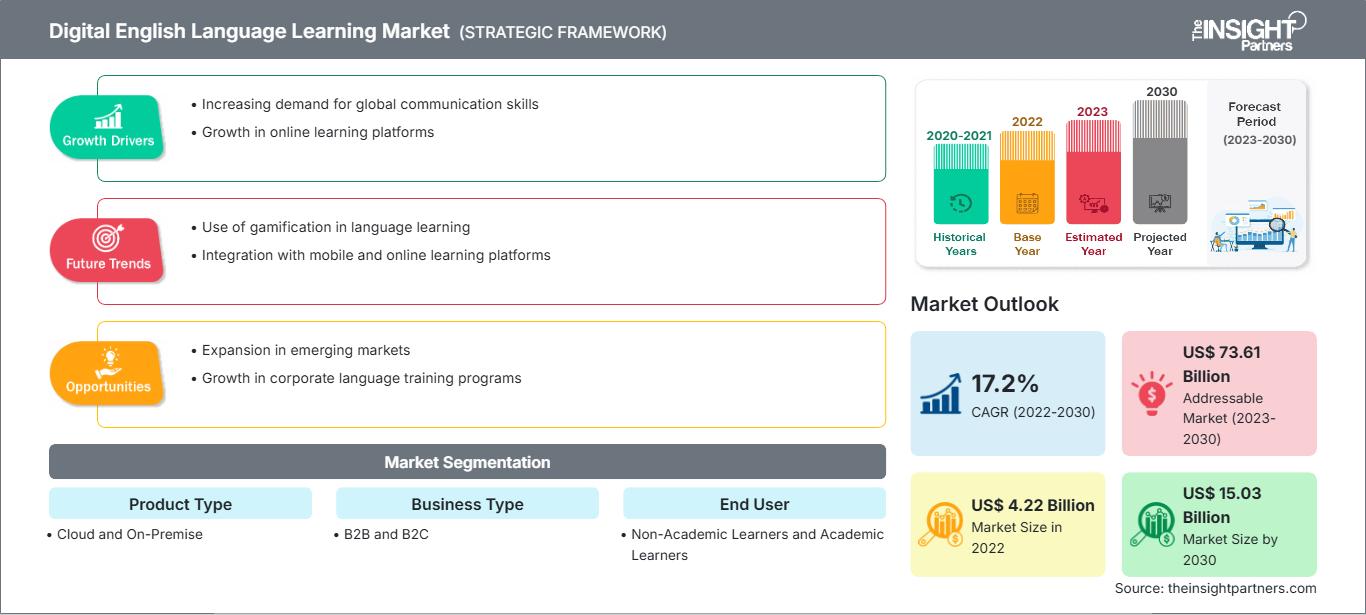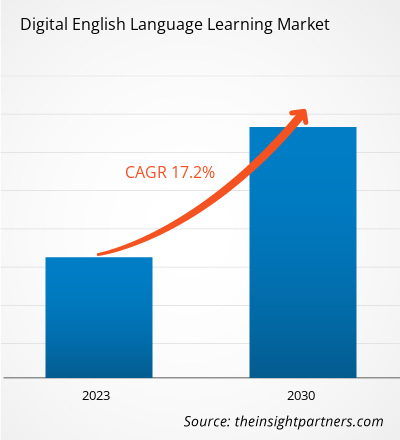[研究报告] 2022 年数字英语学习市场价值为 42.2 亿美元,预计到 2030 年将达到 150.3 亿美元;预计 2022 年至 2030 年的复合年增长率为 17.2%。
数字英语学习市场趋势包括虚拟现实和增强现实的使用日益增多。
分析师观点:
从全球商业角度来看,英语是最受欢迎的语言,近 30 个国家将英语作为其主要的交流语言。因此,英语已被各行各业视为一种通用的交流语言。由于全球化程度不断提高,业务不断扩展到世界各地,英语被视为一种强制性的交流语言,这推动了数字英语学习市场的增长。数字英语学习包括数字内容和产品,可通过各种基于 ICT 的交互式工具促进轻松学习。各种互动工具包括移动应用程序、电子书、音频剪辑、视频、游戏、数字软件和在线辅导。
数字英语学习市场竞争激烈且碎片化。随着该市场的领先公司通过多元化客户群、扩展现有产品组合以及开发新的应用程序和市场来扩大其目标市场,所有主要参与者都面临着日益激烈的竞争,既有来自初创企业,也有来自全球领先的成熟企业。价值链中的多家公司通过收购或合并市场中的其他参与者来保持其地位并为客户提供高效的解决方案。
数字英语学习市场概述:
数字革命几乎改变了社会的方方面面。信息和通信技术 (ICT) 行业的巨大进步为包括教育在内的各个商业领域带来了范式转变。数字化对教育领域产生了深远的影响,教育领域利用技术的力量简化学习过程,使其与学生互动。教育领域数字化的兴起推动了数字英语学习市场的增长,因为数字英语学习平台以创新和互动的方式帮助学生提高英语水平。
随着人工智能 (AI) 在科技领域的渗透率不断提高,英语学习行业预计将发生重大变化。将人工智能融入英语学习工具,可以根据从多个来源收集的数据提供定制的语言学习解决方案。许多其他工具也正在投入研发并投入商业使用,以使英语学习变得更容易、更具互动性,这导致了人们采用数字英语学习平台来学习英语。因此,在未来几年,使用人工智能技术进行英语学习可能会对数字英语学习市场规模产生重大影响。
自定义此报告以满足您的要求
您将免费获得任何报告的定制,包括本报告的部分内容,或国家级分析、Excel 数据包,以及为初创企业和大学提供超值优惠和折扣
数字英语语言学习市场: 战略洞察

- 获取本报告的主要市场趋势。这个免费样本将包括数据分析,从市场趋势到估计和预测。
您将免费获得任何报告的定制,包括本报告的部分内容,或国家级分析、Excel 数据包,以及为初创企业和大学提供超值优惠和折扣
数字英语语言学习市场: 战略洞察

- 获取本报告的主要市场趋势。这个免费样本将包括数据分析,从市场趋势到估计和预测。
数字英语学习市场驱动力:教育领域数字化的兴起推动了数字英语学习市场的增长
在21世纪,技术正在接管每个行业。发展中国家的教育部门是数字化快速发展的行业之一。中国、印度和巴西等发展中国家对数字化教育的需求很高。中国、韩国和澳大利亚的学校旨在让学生做好准备,跟上快速变化的数字化世界的步伐。教育领域的数字化是推动中国、日本和阿联酋等非英语国家英语学习的关键因素。印度是教育领域数字化蓬勃发展的顶级国家之一,预计未来几年将形成一个巨大的市场。
数字化学习涉及多种技术,可以提高学生学习、口语和写作英语以及学习其他科目的能力。一些技术包括在线课程、数字教科书、在线考试和动画。数字化教育使全球各国的教育部门实现了现代化,其他一些发展中国家也越来越多地采用数字化教育,以帮助学生达到西方国家学生的水平。此外,许多公司也在推出英语学习平台。例如,中国高等教育出版社于2020年4月28日正式推出iCourse国际版。英语是该平台的主要语言,同时还提供其他语言版本。同样,学堂在线于2020年4月发布了MOOC平台的国际版,以及首批109门英语在线课程。
中国、印度、巴西和阿联酋等国家的学生对在线英语语法课程的需求不断增长,以及学校、大学和教育机构采用的现代技术促进了数字英语学习市场的增长。
数字英语学习市场细分分析:
数字英语学习市场根据产品类型、业务类型和最终用户进行细分。根据产品类型,市场分为云端和本地部署。根据业务类型,市场分为 B2B 和 B2C。根据最终用户,市场分为非学术学习者和学术学习者。
云端细分市场在 2022 年占据了更大的数字英语学习市场份额,预计在预测期内将录得更高的复合年增长率。基于云端的数字英语学习是指在线课程。由于互联网在全球的普及率不断提高,提供在线学习资料以提高英语学习能力的公司正在受益。这些在线平台使学生能够从课程中学习,也方便学生进行在线考试,以根据自己的能力进行自我评估。电子书和在线学习资料正越来越受欢迎,因为它们允许学生从不同的网络内容中学习。此外,在线网络研讨会、在线辅导和在线课程为学生提供即时提示和反馈,从而提高他们的英语学习能力。
互联网普及率的显著提高正在推动云端细分市场的数字英语学习市场的扩张。此外,使用智能手机和平板电脑可以帮助学生随时随地学习,提高他们的英语口语和写作能力。
数字英语学习市场区域分析:
数字英语学习市场报告的范围涵盖北美、欧洲、亚太地区、中东和非洲以及南美洲和中美洲。就收入而言,亚太地区在 2022 年占据了主导地位。
亚太地区包括中国、印度、澳大利亚、新加坡和韩国等国家。这些国家的教育水平有所提高。他们正在使用一切可能的方法和模式来提高英语水平,目的是增加英语使用者的数量。根据英孚教育的首次英语水平测试,在非英语母语人士中,亚洲位居第二,仅次于欧洲。多年来,亚太地区国家一直在大力投资英语,并为英语学习提供了丰厚的机会。
数字化转型是近年来严重影响亚太地区教育行业的另一个因素。中国和澳大利亚是实施大学和中小学数字化教育最为突出的国家。数字化教育也提供英语学习。然而,韩国和中国在亚太地区数字化英语学习市场中占据领先地位。印度在“数字化印度”倡议下实施了多项举措,以提升数字化教育水平。同样,DIKSHA 是印度的数字化基础设施,为各年级的学校教育提供高质量的电子内容(单元测试、单元测试单元)和二维码激活教科书。截至 2023 年 6 月,DIKSHA 已累计超过 52.4 亿个学习课程、超过 612.5 亿个学习分钟和超过 2200 万个学习会话。这些举措正在推动亚太地区数字化英语学习市场显著增长。
数字英语语言学习市场区域洞察
The Insight Partners 的分析师已详尽阐述了预测期内影响数字英语语言学习市场的区域趋势和因素。本节还讨论了北美、欧洲、亚太地区、中东和非洲以及南美和中美洲的数字英语语言学习市场细分和地域分布。
数字英语语言学习市场报告范围
| 报告属性 | 细节 |
|---|---|
| 市场规模 2022 | US$ 4.22 Billion |
| 市场规模 2030 | US$ 15.03 Billion |
| 全球复合年增长率 (2022 - 2030) | 17.2% |
| 历史数据 | 2020-2021 |
| 预测期 | 2023-2030 |
| 涵盖的领域 |
By 产品类型
|
| 覆盖地区和国家 | 北美
|
| 市场领导者和主要公司简介 |
|
数字英语语言学习市场参与者密度:了解其对商业动态的影响
数字英语学习市场正在快速增长,这得益于终端用户需求的不断增长,而这些需求的驱动因素包括消费者偏好的演变、技术进步以及对产品优势的认知度的提升。随着需求的增长,企业正在扩展其产品线,不断创新以满足消费者需求,并抓住新兴趋势,从而进一步推动市场增长。

- 获取 数字英语语言学习市场 主要参与者概述
数字英语语言学习市场分析基于主要参与者的年度表现,例如 EF Education First、ELSA Corp.、Houghton Mifflin Harcourt Co、MACMILLAN、牛津大学出版社、Pearson Plc、Sanako Corporation、Babbel GmbH、Transparent Language、Vipkid、剑桥大学出版社、Voxy、Chegg Inc、Duolingo Inc、INLINGUA INTERNATIONAL LTD.、Berlitz Corporation 和 IXL Learning。还分析了其他几个主要市场参与者,以全面了解市场及其生态系统。
最新发展:
数字英语语言学习市场报告强调了支撑市场的关键因素和知名参与者的发展。市场参与者专注于无机和有机战略来实现业务增长。根据公司新闻稿,以下是近期的一些关键进展:
- 2023 年 7 月,Berlitz 与微软合作,特别是 Azure AI Speech 及其发音评估功能。借助这项技术,Berlitz 能够以最快、最有效的方式学习新语言,同时又具备更高的灵活性,使 Berlitz 能够触达更多学习者。
- 2021 年 3 月,个性化学习产品开发商 IXL Learning 收购了基于技术的语言教育平台 Rosetta Stone。
- 历史分析(2 年)、基准年、预测(7 年)及复合年增长率
- PEST和SWOT分析
- 市场规模、价值/数量 - 全球、区域、国家
- 行业和竞争格局
- Excel 数据集
近期报告
相关报告
客户评价
购买理由
- 明智的决策
- 了解市场动态
- 竞争分析
- 客户洞察
- 市场预测
- 风险规避
- 战略规划
- 投资论证
- 识别新兴市场
- 优化营销策略
- 提升运营效率
- 顺应监管趋势




















 获取免费样品 - 数字英语语言学习市场
获取免费样品 - 数字英语语言学习市场